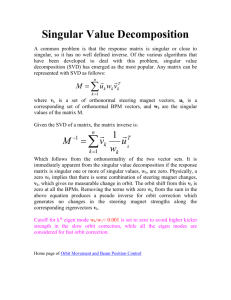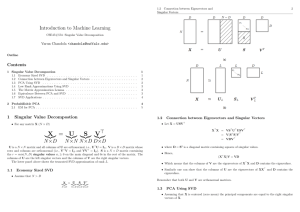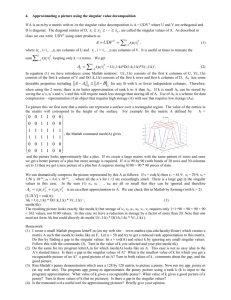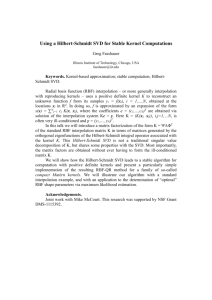Singular Value Decomposition
advertisement
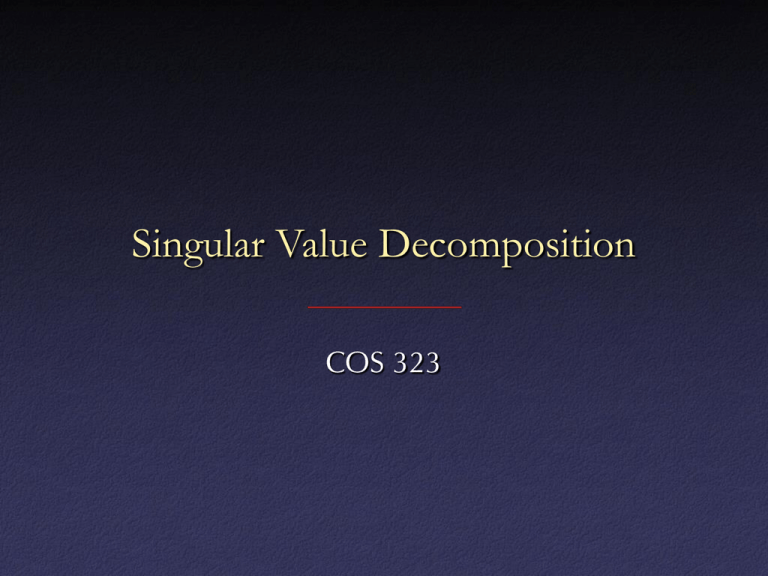
Singular Value Decomposition COS 323 Underconstrained Least Squares • What if you have fewer data points than parameters in your function? – Intuitively, can’t do standard least squares – Recall that solution takes the form ATAx = ATb – When A has more columns than rows, ATA is singular: can’t take its inverse, etc. Underconstrained Least Squares • More subtle version: more data points than unknowns, but data poorly constrains function • Example: fitting to y=ax2+bx+c Underconstrained Least Squares • Problem: if problem very close to singular, roundoff error can have a huge effect – Even on “well-determined” values! • Can detect this: – Uncertainty proportional to covariance C = (ATA)-1 – In other words, unstable if ATA has small values – More precisely, care if xT(ATA)x is small for any x • Idea: if part of solution unstable, set answer to 0 – Avoid corrupting good parts of answer Singular Value Decomposition (SVD) • Handy mathematical technique that has application to many problems • Given any mn matrix A, algorithm to find matrices U, V, and W such that A = U W VT U is mn and orthonormal W is nn and diagonal V is nn and orthonormal SVD A U w1 0 0 0 0 0 0 wn V • Treat as black box: code widely available In Matlab: [U,W,V]=svd(A,0) T SVD • The wi are called the singular values of A • If A is singular, some of the wi will be 0 • In general rank(A) = number of nonzero wi • SVD is mostly unique (up to permutation of singular values, or if some wi are equal) SVD and Inverses • Why is SVD so useful? • Application #1: inverses • A-1=(VT)-1 W-1 U-1 = V W-1 UT – Using fact that inverse = transpose for orthogonal matrices – Since W is diagonal, W-1 also diagonal with reciprocals of entries of W SVD and Inverses • A-1=(VT)-1 W-1 U-1 = V W-1 UT • This fails when some wi are 0 – It’s supposed to fail – singular matrix • Pseudoinverse: if wi=0, set 1/wi to 0 (!) – “Closest” matrix to inverse – Defined for all (even non-square, singular, etc.) matrices – Equal to (ATA)-1AT if ATA invertible SVD and Least Squares • Solving Ax=b by least squares • x=pseudoinverse(A) times b • Compute pseudoinverse using SVD – Lets you see if data is singular – Even if not singular, ratio of max to min singular values (condition number) tells you how stable the solution will be – Set 1/wi to 0 if wi is small (even if not exactly 0) SVD and Eigenvectors • Let A=UWVT, and let xi be ith column of V • Consider ATA xi: 0 0 2 2 T T T T 2 T 2 A Axi VW U UWV xi VW V xi VW 1 V wi wi xi 0 0 • So elements of W are sqrt(eigenvalues) and columns of V are eigenvectors of ATA – What we wanted for robust least squares fitting! SVD and Matrix Similarity • One common definition for the norm of a matrix is the Frobenius norm: A F aij i 2 j • Frobenius norm can be computed from SVD A F wi i 2 • So changes to a matrix can be evaluated by looking at changes to singular values SVD and Matrix Similarity • Suppose you want to find best rank-k approximation to A • Answer: set all but the largest k singular values to zero • Can form compact representation by eliminating columns of U and V corresponding to zeroed wi SVD and PCA • Principal Components Analysis (PCA): approximating a high-dimensional data set with a lower-dimensional subspace * * Second principal component * * First principal component * * * * * * * ** * * Original axes * * * * * ** * * Data points SVD and PCA • Data matrix with points as rows, take SVD – Subtract out mean (“whitening”) • Columns of Vk are principal components • Value of wi gives importance of each component PCA on Faces: “Eigenfaces” Average face First principal component Other components For all except average, “gray” = 0, “white” > 0, “black” < 0 Using PCA for Recognition • Store each person as coefficients of projection onto first few principal components imax image ai Eigenface i 0 i • Compute projections of target image, compare to database (“nearest neighbor classifier”) Total Least Squares • One final least squares application • Fitting a line: vertical vs. perpendicular error Total Least Squares • Distance from point to line: xi d i n a yi where n is normal vector to line, a is a constant • Minimize: xi d n a i i yi 2 2 i 2 Total Least Squares • First, let’s pretend we know n, solve for a xi n a i yi 1 xi a n m i yi 2 2 • Then xi x x i i m n di n a y yi y i i m Total Least Squares • So, let’s define and minimize xi xi mxi ~ ~ y yi y i i m 2 ~ xi i ~y n i Total Least Squares • Write as linear system • Have An=0 x1 ~ ~ x2 ~ x3 ~ y1 ~ y2 nx 0 ~ y3 n y – Problem: lots of n are solutions, including n=0 – Standard least squares will, in fact, return n=0 Constrained Optimization • Solution: constrain n to be unit length • So, try to minimize |An|2 subject to |n|2=1 2 T T T An An An n A A n • Expand in eigenvectors ei of ATA: n 1e1 2e 2 T T n A A n 112 2 22 2 n 12 22 where the i are eigenvalues of ATA Constrained Optimization • To minimize 112 2 22 subject to 12 22 1 set min = 1, all other i = 0 • That is, n is eigenvector of ATA with the smallest corresponding eigenvalue

